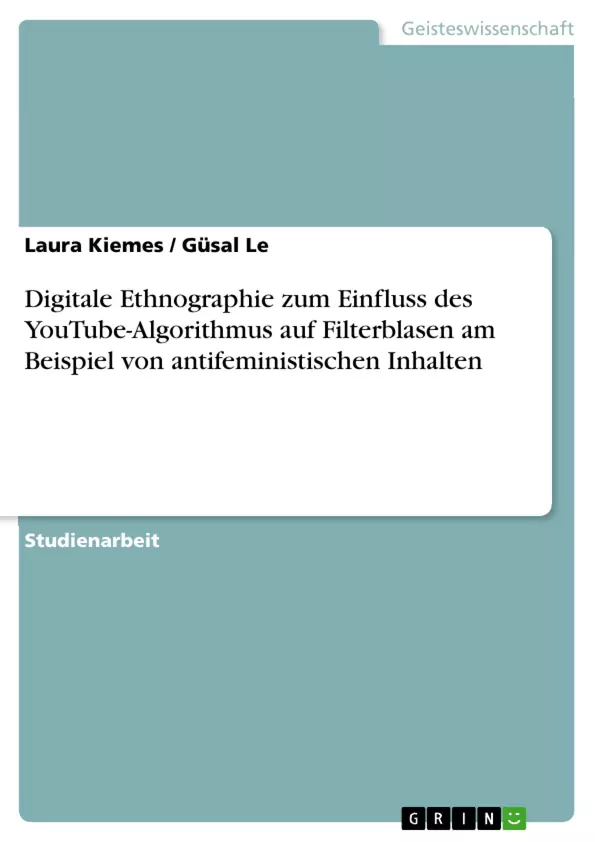Stell dir vor, deine digitale Realität wird von unsichtbaren Fäden gewebt, Algorithmen, die bestimmen, was du siehst und glaubst. Aber was, wenn diese Fäden dich in eine Echokammer führen, in der nur deine eigenen Überzeugungen widerhallen? Diese packende Analyse taucht tief in die verborgenen Mechanismen des YouTube-Algorithmus ein und enthüllt, wie dieser die Entstehung von Filterblasen befeuert, insbesondere im kontroversen Feld des Antifeminismus. Durch die Linse der digitalen Ethnographie, werden Nutzererfahrungen seziert, die offenbaren, wie algorithmische Empfehlungen Meinungen verstärken und Andersdenkende ausblenden. Erfahre, wie scheinbar neutrale Algorithmen unbeabsichtigt zur Verbreitung von Ideologien beitragen und die Grenzen zwischen Information und Manipulation verschwimmen lassen. Diese tiefgreifende Untersuchung enthüllt, wie der YouTube-Algorithmus, oft unbemerkt, unsere Wahrnehmung der Welt formt und welche Konsequenzen dies für den gesellschaftlichen Diskurs hat. Die Ergebnisse der Interviews und teilnehmenden Beobachtungen auf YouTube zeigen, wie Nutzer in algorithmisch gesteuerte Schleifen geraten, in denen antifeministische Inhalte verstärkt und alternative Perspektiven unterdrückt werden. Diese Arbeit ist ein Weckruf, der uns auffordert, die Macht der Algorithmen zu hinterfragen und die Verantwortung für unsere eigene Informationsselektion zu übernehmen. Ein Muss für jeden, der verstehen will, wie soziale Medien unsere Meinungen formen und wie wir uns vor den subtilen Einflüssen der algorithmischen Selektion schützen können. Die Studie beleuchtet die komplexen Wechselwirkungen zwischen Technologie, Ideologie und Nutzerverhalten im digitalen Zeitalter und liefert wertvolle Einblicke in die Funktionsweise von Online-Gemeinschaften und die Verbreitung von kontroversen Inhalten im Internet. Sie wirft ein kritisches Licht auf die Rolle von Algorithmen in der Meinungsbildung und zeigt, wie wichtig es ist, algorithmische Prozesse zu verstehen und kritisch zu hinterfragen. Die gewonnenen Erkenntnisse sind relevant für alle, die sich mit sozialen Medien, digitaler Kommunikation und den gesellschaftlichen Auswirkungen von Technologie auseinandersetzen.
Inhaltsverzeichnis
- 1 Einleitung
- 1.1 Themenfeld
- 1.2 Forschungsfrage
- 1.3 Forschungsstand
- 1.4 Methode und Material
- 1.4.1 Leitfadeninterview
- 1.4.2 Teilnehmende Beobachtung
- 1.4.3 Qualitative Inhaltsanalyse
- 2 Ergebnisse
- 2.1 Interviews
- 2.1.1 Beginn
- 2.1.2 Funktionsweise des Algorithmus
- 2.1.3 Austritt
- 2.2 Teilnehmende Beobachtung auf YouTube
- 2.2.1 Woche 1
- 2.2.2 Woche 2
- 2.2.3 Woche 3
- 2.2.4 Woche 4
- 3 Fazit
- 3.1 Schlussfolgerungen
- 3.2 Selbstreflexion
- 3.3 Limitationen
- 3.4 Ausblick
Zielsetzung und Themenschwerpunkte
Diese Arbeit untersucht den Einfluss des YouTube-Algorithmus auf die Bildung von Filterblasen, speziell im Kontext antifeministischer Inhalte. Ziel ist es, mithilfe digitaler ethnografischer Methoden zu analysieren, wie Algorithmen das Nutzererlebnis prägen und welche Auswirkungen dies auf die Rezeption von Inhalten hat. Die Studie konzentriert sich auf die Nutzerperspektive und deren Erfahrungen mit dem Algorithmus.
- Der Einfluss von YouTube-Algorithmen auf die Informationsselektion
- Die Entstehung und Wirkung von Filterblasen im Kontext antifeministischer Inhalte
- Die Nutzererfahrung und -wahrnehmung algorithmisch gesteuerter Empfehlungen
- Digitale Ethnographie als Methode zur Untersuchung algorithmischer Prozesse
- Die Rolle von Algorithmen in der Verbreitung von Ideologien online
Zusammenfassung der Kapitel
1 Einleitung: Die Einleitung führt in das Thema ein und beschreibt den allgegenwärtigen Einfluss von Algorithmen auf unser digitales Leben, insbesondere auf Social-Media-Plattformen wie YouTube. Sie skizziert die Forschungsfrage, die sich mit dem Einfluss des YouTube-Algorithmus auf die Bildung von Filterblasen im Kontext antifeministischer Inhalte befasst. Der Forschungsstand wird kurz angerissen und die gewählte Methodik – digitale Ethnographie – wird eingeführt. Die Einleitung legt den Grundstein für die nachfolgende Untersuchung, indem sie die Relevanz des Themas hervorhebt und den Rahmen der Arbeit absteckt. Der Bezug zu den alltäglichen Erfahrungen der Nutzer wird hergestellt, um die Brisanz des Themas zu verdeutlichen.
2 Ergebnisse: Dieses Kapitel präsentiert die Ergebnisse der durchgeführten Interviews und der teilnehmenden Beobachtung auf YouTube. Die Interviews beleuchten die Nutzerperspektiven und Erfahrungen mit dem Algorithmus. Die teilnehmende Beobachtung liefert detaillierte Einblicke in die Funktionsweise des Algorithmus und die Art und Weise, wie antifeministische Inhalte präsentiert und konsumiert werden. Durch die Analyse der Daten werden Muster und Zusammenhänge aufgezeigt, die den Einfluss des Algorithmus auf die Filterblasenbildung verdeutlichen. Die Ergebnisse werden differenziert nach den verschiedenen Phasen der Untersuchung (Interviews und Beobachtungsphasen) dargestellt. Hier wird die Rohdatenanalyse zu Erkenntnissen über den Einfluss von YouTube Algorithmen auf die Bildung von Filterblasen zusammengefasst.
Schlüsselwörter
Digitale Ethnographie, YouTube-Algorithmus, Filterblasen, Antifeminismus, Online-Gemeinschaften, Algorithmische Selektion, Nutzererfahrung, Qualitative Inhaltsanalyse, Soziale Medien, Ideologie, Internetkultur.
Häufig gestellte Fragen
Was ist das Thema dieses Dokuments?
Dieses Dokument ist eine Sprachvorschau, die Titel, Inhaltsverzeichnis, Ziele und Themenschwerpunkte, Kapitelzusammenfassungen und Schlüsselwörter enthält. Es untersucht den Einfluss des YouTube-Algorithmus auf die Bildung von Filterblasen, speziell im Kontext antifeministischer Inhalte.
Was sind die Forschungsfragen, die in dieser Arbeit untersucht werden?
Die Arbeit untersucht, wie der YouTube-Algorithmus die Informationsselektion beeinflusst, die Entstehung und Wirkung von Filterblasen im Kontext antifeministischer Inhalte, die Nutzererfahrung und -wahrnehmung algorithmisch gesteuerter Empfehlungen, die Anwendung digitaler Ethnographie zur Untersuchung algorithmischer Prozesse und die Rolle von Algorithmen in der Verbreitung von Ideologien online.
Welche Methoden werden verwendet, um diese Fragen zu beantworten?
Die Arbeit verwendet eine digitale ethnografische Methode, die Leitfadeninterviews, teilnehmende Beobachtung auf YouTube und qualitative Inhaltsanalyse umfasst.
Was sind die wichtigsten Kapitel dieser Arbeit?
Die wichtigsten Kapitel sind: 1. Einleitung, 2. Ergebnisse und 3. Fazit. Die Einleitung führt in das Thema ein und beschreibt die Forschungsfrage und Methodik. Das Ergebniskapitel präsentiert die Ergebnisse der Interviews und der teilnehmenden Beobachtung. Das Fazit zieht Schlussfolgerungen, reflektiert die eigene Arbeit, benennt Limitationen und gibt einen Ausblick.
Was wird im Ergebniskapitel präsentiert?
Das Ergebniskapitel präsentiert die Ergebnisse der durchgeführten Interviews und der teilnehmenden Beobachtung auf YouTube, die Einblicke in die Funktionsweise des Algorithmus und die Art und Weise geben, wie antifeministische Inhalte präsentiert und konsumiert werden.
Welche Schlüsselwörter sind mit dieser Arbeit verbunden?
Die Schlüsselwörter sind: Digitale Ethnographie, YouTube-Algorithmus, Filterblasen, Antifeminismus, Online-Gemeinschaften, Algorithmische Selektion, Nutzererfahrung, Qualitative Inhaltsanalyse, Soziale Medien, Ideologie, Internetkultur.
Was ist das Ziel der Studie?
Ziel ist es, mithilfe digitaler ethnografischer Methoden zu analysieren, wie Algorithmen das Nutzererlebnis prägen und welche Auswirkungen dies auf die Rezeption von Inhalten hat, wobei der Fokus auf der Nutzerperspektive und deren Erfahrungen mit dem Algorithmus liegt.
- Quote paper
- Laura Kiemes (Author), Güsal Le (Author), 2022, Digitale Ethnographie zum Einfluss des YouTube-Algorithmus auf Filterblasen am Beispiel von antifeministischen Inhalten, Munich, GRIN Verlag, https://www.hausarbeiten.de/document/1395051


